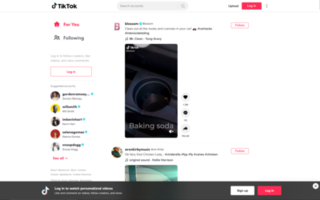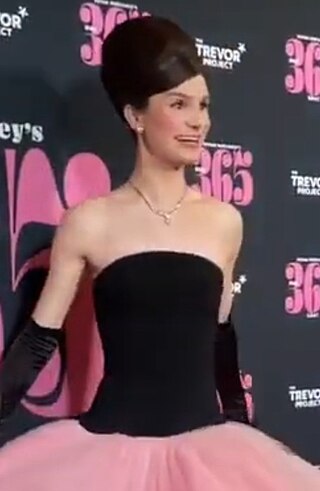In the entertainment industry, sleeper hit refers to a film, television series, music release, video game, or other entertainment product that was unpromising on release but became a surprise success. A sleeper hit may have little promotion or lack a successful launch but gradually develops a fandom following media attention, which in turn increases its public exposure and public interest in the product. As Variety puts it, "A 'sleeper hit' can be defined as the kind of show that catches us by surprise—programs whose popularity grows over time and can ultimately outshine the preordained hits." A sleeper hit often lacks star performers or high production values, but prevails, at times against its own makers' expectations, on the strength of such qualities as narrative, approach, or novelty, as well as market accidents. Sleeper hit films benefit theater owners because the owners keep a larger percentage of money from ticket sales.
Kahn & Bell was a fashion label and boutique established by Jane Kahn and Patti Bell in Hurst Street, Birmingham, England in 1976. At the forefront of the emergence of the look of the New Romantic movement they designed clothes for notable bands including Duran Duran and Shock. Simon Le Bon wrote the Duran Duran song Khanada about Jane Kahn.

TikTok, whose mainland Chinese counterpart is Douyin, is a short-form video hosting service owned by Chinese internet company ByteDance. It hosts user-submitted videos, which can range in duration from three seconds to 10 minutes. It can be accessed with a smart phone app.
"OK boomer" or "okay boomer" is a catchphrase and internet meme that has been used by members of the Millennial generation and Generation Z to dismiss or mock attitudes typically associated with baby boomers – people born in the two decades following World War II. The phrase first drew widespread attention due to a November 2019 TikTok video in response to an older man, though the phrase had been coined years before that. Considered by some to be ageist, the phrase has developed into a retort for resistance to technological change, climate change denial, marginalization of members of minority groups, or opposition to younger generations' values.
For music from a year in the 2020s, go to 20 | 21 | 22 | 23 | 24

Charli Grace D'Amelio is an American social media personality. She was a competitive dancer for over a decade before starting her social media career in 2019, when she began posting dance videos on the video-sharing platform TikTok. She quickly amassed a large following and subsequently became the most-followed creator on the platform in March 2020 until she was surpassed by Khaby Lame in June 2022. With over 151 million followers, she is the second-most-followed-person on TikTok, as of 2024.

E-girls and e-boys, sometimes collectively known as e-kids, are a youth subculture of Gen Z that emerged in the late 2010s, notably popularized by the video-sharing application TikTok. It is an evolution of emo, scene and mall goth fashion combined with Japanese and Korean street fashion.

Cottagecore is an internet aesthetic idealising rural life. Originally based on a rural European life, it was developed throughout the 2010s and was first named cottagecore on Tumblr in 2018. The aesthetic centres on traditional rural clothing, interior design, and crafts such as drawing, baking, and pottery, and is related to similar aesthetic movements such as grandmacore, goblincore, gnomecore and fairycore.

Dark academia is an internet aesthetic and subculture concerned with higher education, the arts, and literature, or an idealised version thereof. The aesthetic centres on traditional educational clothing, interior design, activities such as writing and poetry, ancient art, and classic literature, as well as classical Greek and Collegiate Gothic architecture. The trend emerged on social media site Tumblr in 2015, before being popularised by adolescents and young adults in the late 2010s and early 2020s, particularly during the COVID-19 pandemic.

The fashions of the 2020s represent a departure from 2010s fashion and feature a nostalgia for older aesthetics. They have been largely inspired by styles of the late 1990s to mid-2000s, 1980s, and late 1960s to early 1970s Early in the decade, several publications noted the shortened trend and nostalgia cycle in 2020s fashion. Fashion was also shaped by the COVID-19 pandemic, which had a major impact on the fashion industry, and led to shifting retail and consumer trends.
Abbie Richards is a misinformation educator and environmental activist whose conspiracy theory charts went viral on Twitter in 2020 and 2021.
TikTok food trends are specific food recipes and food-related fads on the social media platform TikTok. This content amassed popularity in 2020 during the COVID-19 pandemic, as many people cooked and ate at home and more people turned to social media for entertainment. While some TikTok users share their diets and recipes, others expand their brand or image on TikTok through step-by-step videos of easy and popular recipes. Users often refer to food-related content as "FoodTok."

A devious lick was a challenge in which North American middle school and high school students posted videos of themselves stealing, vandalizing, or showing off one or more items they stole in their school, typically from a bathroom. The trend went viral on TikTok in 2021 and has resulted in the arrests of many students as well as various warnings being issued by police departments. It also allegedly spread to some schools in Latin America, England, Germany, Australia and Latvia.

Indie sleaze was a fashion style popular in the United States and United Kingdom from approximately 2006 to 2012. Characterised by an affordable, messy and lethargic take on vintage fashion styles, especially the 1970s, the style was particularly popular amongst the hipster subculture and indie rock bands.

YouTube Shorts is the short-form section of the American video-sharing site YouTube. Shorts focuses on vertical videos at a maximum length of 60 seconds and various features for user interaction. As of March 2024, Shorts have collectively earned over 5 trillion views since the platform was made available to the public on July 13, 2021, which include video views that pre-date the YouTube Shorts feature. Creators earn money based on the amount of views they receive, or through ad revenue. The increased popularity of YouTube Shorts has led to concerns about addiction for teenagers.

BeReal is a French messaging app released in 2020, developed by Alexis Barreyat and Kévin Perreau. Its main feature is a daily notification that encourages users to share photos with friends of themselves and their day to day life given a randomly selected two-minute window every day. Critics noted its emphasis on authenticity, which some felt crossed the line into the mundane. The name "BeReal" is a pun. Its primary reference relates to its focus on users uploading unpolished photos, while also being a pun of the term b-reel.

Libs of TikTok is a handle for various far-right and anti-LGBT social-media accounts operated by Chaya Raichik, a former real estate agent. Raichik uses the accounts to repost content created by left-wing and LGBT people on TikTok, and on other social-media platforms, often with hostile, mocking, or derogatory commentary. The accounts promote hate speech and transphobia, and spread false claims, especially relating to medical care of transgender children. The Twitter account, also known by the handle @LibsofTikTok, has nearly 3 million followers as of February 2024 and has become influential among American conservatives and the political right. Libs of TikTok's social-media accounts have received several temporary suspensions and a permanent suspension from TikTok.
An Internet aesthetic, also simply referred to as an aesthetic or microaesthetic, is a visual art style, sometimes accompanied by a fashion style, subculture, or music genre, that usually originates from the Internet or is popularized on it. Throughout the 2010s and 2020s, online aesthetics gained increasing popularity, specifically on social media platforms such as Tumblr, Pinterest, Instagram, and TikTok, and often were used by people to express their individuality and creativity. They can also be used to create a sense of community and belonging among people who share the same interests. The term aesthetic has been described as being "totally divorced from its academic origins", and is commonly used as an adjective.

Dylan Mulvaney is an American social media personality who has detailed her gender transition in daily videos published on TikTok since early 2022. She gained a higher profile after her interview with U.S. president Joe Biden at the White House, during which they spoke about transgender rights. After Bud Light sent a can to Mulvaney for an Instagram promotion in 2023, American conservatives led a boycott of the brand.










